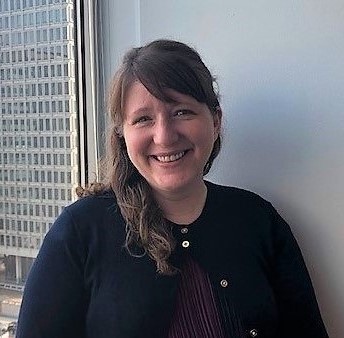Emily McNair, Project Manager, is a seasoned development and communications professional whose work at Fairmount channels her direct experience in the human service sector, her passion for writing, and her keen awareness of organizational and interpersonal dynamics. Her client projects span resource development planning, strategic campaign support, and developing tailored materials that position nonprofits successfully among multiple stakeholder audiences. Emily studied Anthropology and holds a B.A. in that field from Bard College.

FV: How do you draw on your experience working in-house at nonprofits to inform your Fairmount role as an external consultant? What past wisdom and skills resonate most?
EM: It requires a frame shift, but there are certainly a lot of transferable skills. I am very cognizant when listening to people and making recommendations of two key things that are informed by my past experiences: 1) keeping the organization’s mission at the forefront of the work, and 2) making space for big dreams while keeping action steps grounded in the reality of the individual client. It can be tempting to fall down a rabbit hole of “what ifs” when evaluating the funding landscape, so it’s important to keep the client, stakeholders, and yourself focused on opportunities and messages that align with and will further the mission. I also think of things from the client’s perspective, and from the perspective of their staff: what is it actually going to take to get this done? The work that we are doing with them is hard work, important work, but the last thing you want to do is create burdens on staff that become barriers to getting the work done.
FV: Writing is a through-line across your communications and development expertise. How do you approach writing on behalf of new clients for their stakeholder audiences?
EM: Writing – and the use of language in general – is something that I genuinely enjoy, so exploring new frames of reference, learning about new things, and taking on new voices are all things that excite me. I’m a voracious reader, particularly of things (fiction or nonfiction) that complicate my worldview, that express ideas in new and challenging ways, or just make me say, “huh, I never thought about that before.” Our clients are the experts in their areas, and I love learning from them. I love hearing how they talk about their work, the challenges they wrestle with, all the things that make them unique. And then I love taking that expertise and crafting it into a story that invites others into their world.
FV: What advice would you give to a resource-challenged nonprofit looking to communicate with multiple generations of donors across multiple print and digital platforms?
EM: I’d start by telling them to look at the data and listen to their donors. Especially when you’ve been inside an organization for a while, it can be easy to make assumptions or hold certain things to be true. “Millennials only give through peer to peer platforms!” “Seniors only write checks!” “People only give to us because of ____.” It can be easiest to just keep doing what you’re doing, and it can be tempting to chase after every new trend that emerges, but neither of these approaches will yield results if you don’t take an unvarnished look at your strategies and results (actual or desired).
Evaluate your mailing list, what you’re mailing, to whom, and how often. Do you have a system for removing or updating bad addresses? What’s the return on each mailing? Digital communications and social media platforms provide a wealth of data about your audience, from email open rates and click throughs, to Facebook analytics. Figure out which audience segments are responding to which channels of communication, and then don’t be afraid to target messages to that core demographic. Develop unique voices (that are still authentic-sounding and true to your organizational voice) for each channel, and take advantage of scheduling tools. Be sure that your digital touch points are integrated with your print schedule, and that your full communications plan is integrated with your development calendar.
FV: What does a typical day look like for you?
EM: I’m not sure that I have a typical day! So much is informed by my current mix of clients, where we are in the arc of the project, the players involved… Recently, a day for me included prepping for and then presenting on our interim findings regarding a capital campaign feasibility study; doing a final proof of a grant proposal I’d written; meeting with team members to strategize and assign tasks for an upcoming campaign meeting; and revising a client’s donor acknowledgement letter to help establish the voice for the campaign collateral materials we are developing together. In between, several of us had lunch together and shared ideas for team-building activities. I guess what is typical – and also what I enjoy – about days here is that no two days are exactly the same.
FV: What are some of your favorite things to do in Philadelphia?
EM: There are so many incredible places to go in Philadelphia, and so many people and organizations doing innovative and extraordinary things. My family and I spend a lot of time in the Wissahickon, and I love the events and activities Friends of the Wissahickon holds – likewise with Bartram’s Garden, Awbury Arboretum, the Discovery Center, and the Philadelphia Zoo. Between the uniqueness of the places themselves and the creativity of the partnerships they forge, we never lack for weekend activities. Philadelphia is also a great town for music – everyone plays here eventually! We try to see as much live music as possible, especially in warmer weather. Is there anything better than seeing an incredible show at the Mann on a perfect summer evening?
